Comprehensive Report: Food Waste and Management in Johor, Malaysia
VerifiedAdded on 2022/12/27
|20
|4337
|1
Report
AI Summary
This report provides a comprehensive analysis of food waste and its management in Johor, Malaysia. It begins by defining food waste, its causes, and its global impact, highlighting the environmental and economic consequences. The report then delves into the specific context of Malaysia, examining the current food waste situation, the role of municipal solid waste, and government initiatives in waste management. It explores the challenges and gaps in existing waste management techniques, emphasizing the need for improved strategies. The literature review covers the concept of food wastage worldwide and in Malaysia, along with an examination of various food waste management tools. The methodology section outlines the data collection, sample size, and data analysis methods used in the study. The report also includes ethical considerations, limitations, and a proposed timeline. The introduction covers background information on food waste, its causes, and impacts, including environmental concerns, economic losses, and ethical considerations. The report aims to analyze the current scenario of food wastage globally and in Malaysia, examine various waste management tools, and identify gaps in current techniques, offering insights into effective food waste reduction and management strategies.
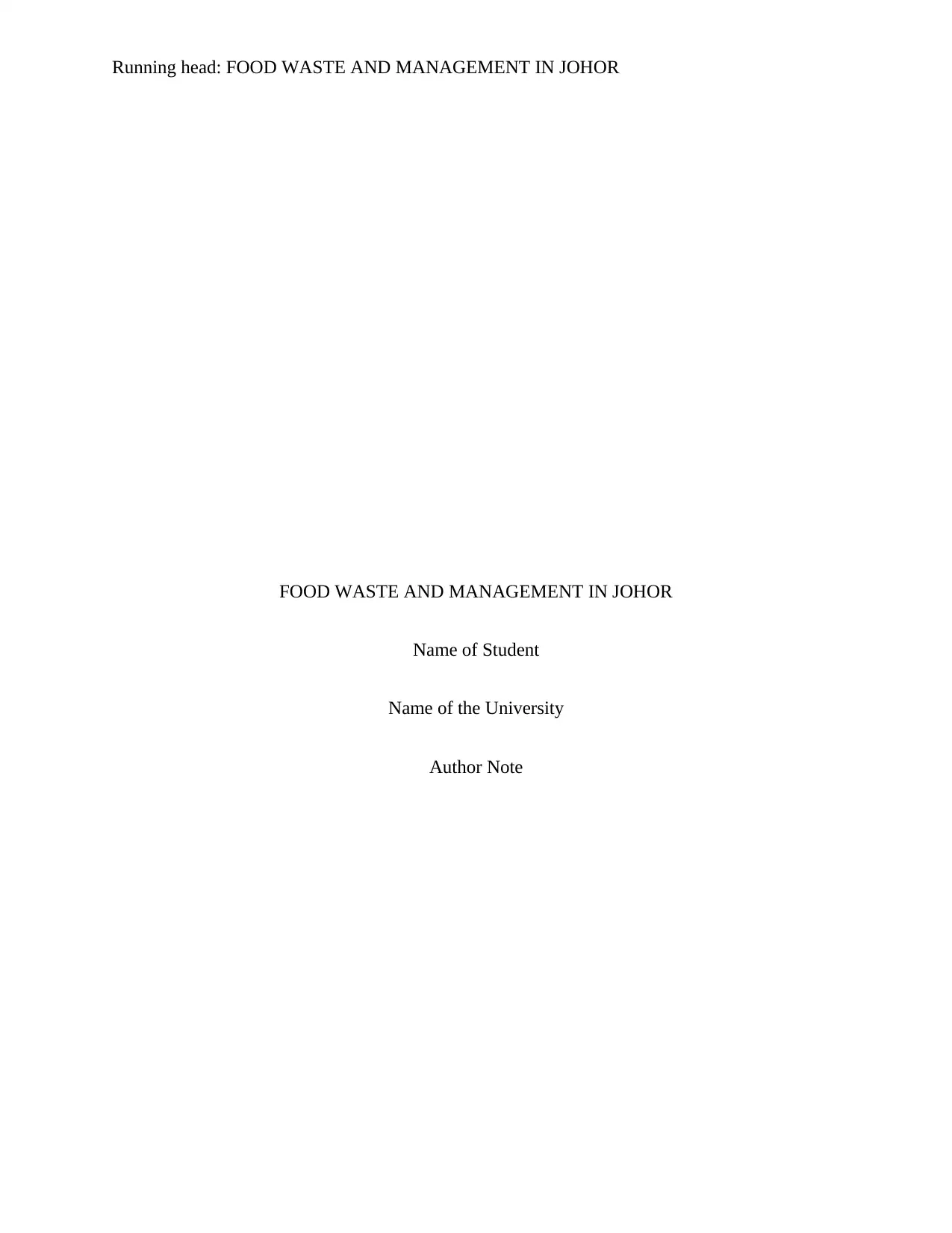
Running head: FOOD WASTE AND MANAGEMENT IN JOHOR
FOOD WASTE AND MANAGEMENT IN JOHOR
Name of Student
Name of the University
Author Note
FOOD WASTE AND MANAGEMENT IN JOHOR
Name of Student
Name of the University
Author Note
Paraphrase This Document
Need a fresh take? Get an instant paraphrase of this document with our AI Paraphraser
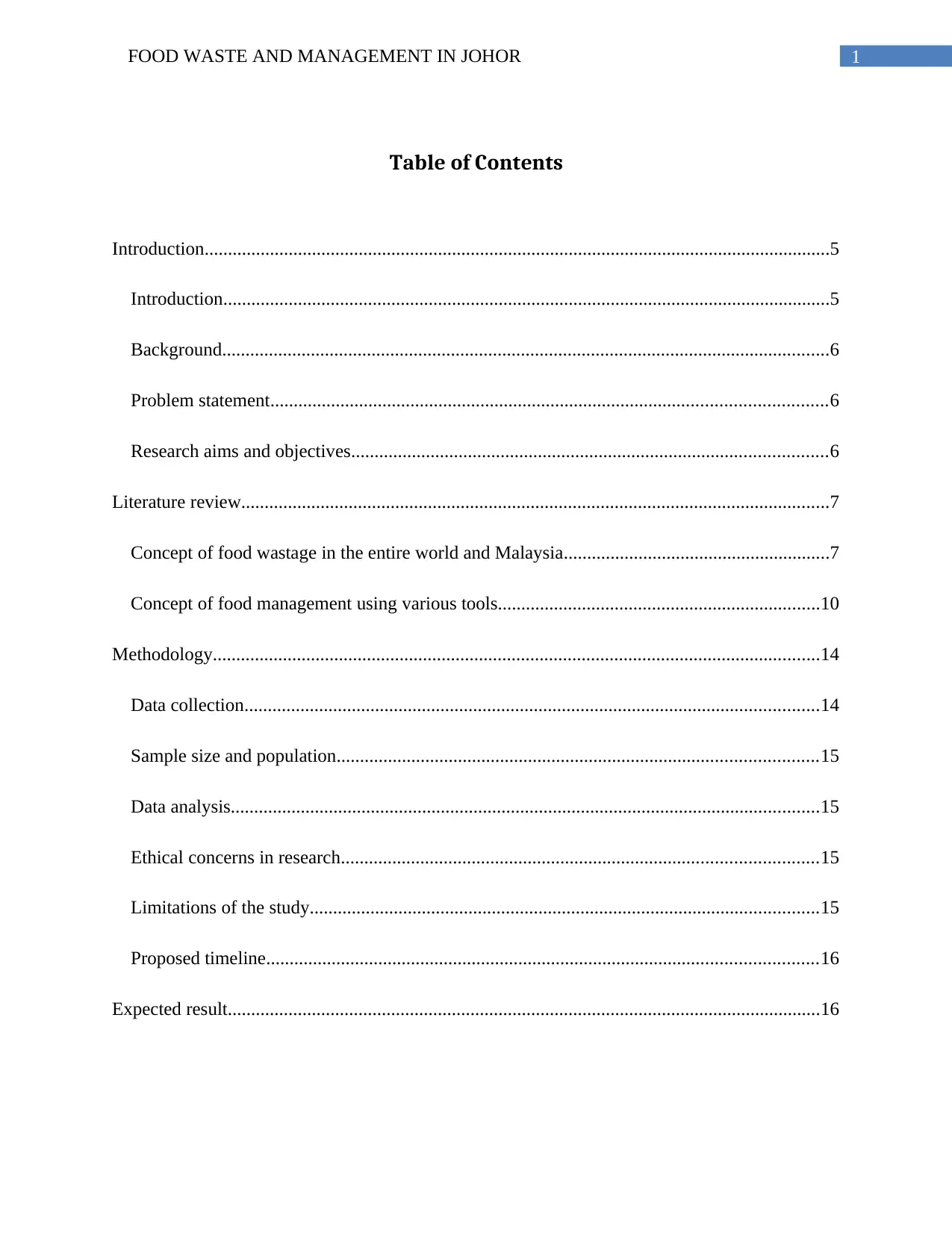
1FOOD WASTE AND MANAGEMENT IN JOHOR
Table of Contents
Introduction......................................................................................................................................5
Introduction..................................................................................................................................5
Background..................................................................................................................................6
Problem statement.......................................................................................................................6
Research aims and objectives......................................................................................................6
Literature review..............................................................................................................................7
Concept of food wastage in the entire world and Malaysia.........................................................7
Concept of food management using various tools.....................................................................10
Methodology..................................................................................................................................14
Data collection...........................................................................................................................14
Sample size and population.......................................................................................................15
Data analysis..............................................................................................................................15
Ethical concerns in research......................................................................................................15
Limitations of the study.............................................................................................................15
Proposed timeline......................................................................................................................16
Expected result...............................................................................................................................16
Table of Contents
Introduction......................................................................................................................................5
Introduction..................................................................................................................................5
Background..................................................................................................................................6
Problem statement.......................................................................................................................6
Research aims and objectives......................................................................................................6
Literature review..............................................................................................................................7
Concept of food wastage in the entire world and Malaysia.........................................................7
Concept of food management using various tools.....................................................................10
Methodology..................................................................................................................................14
Data collection...........................................................................................................................14
Sample size and population.......................................................................................................15
Data analysis..............................................................................................................................15
Ethical concerns in research......................................................................................................15
Limitations of the study.............................................................................................................15
Proposed timeline......................................................................................................................16
Expected result...............................................................................................................................16
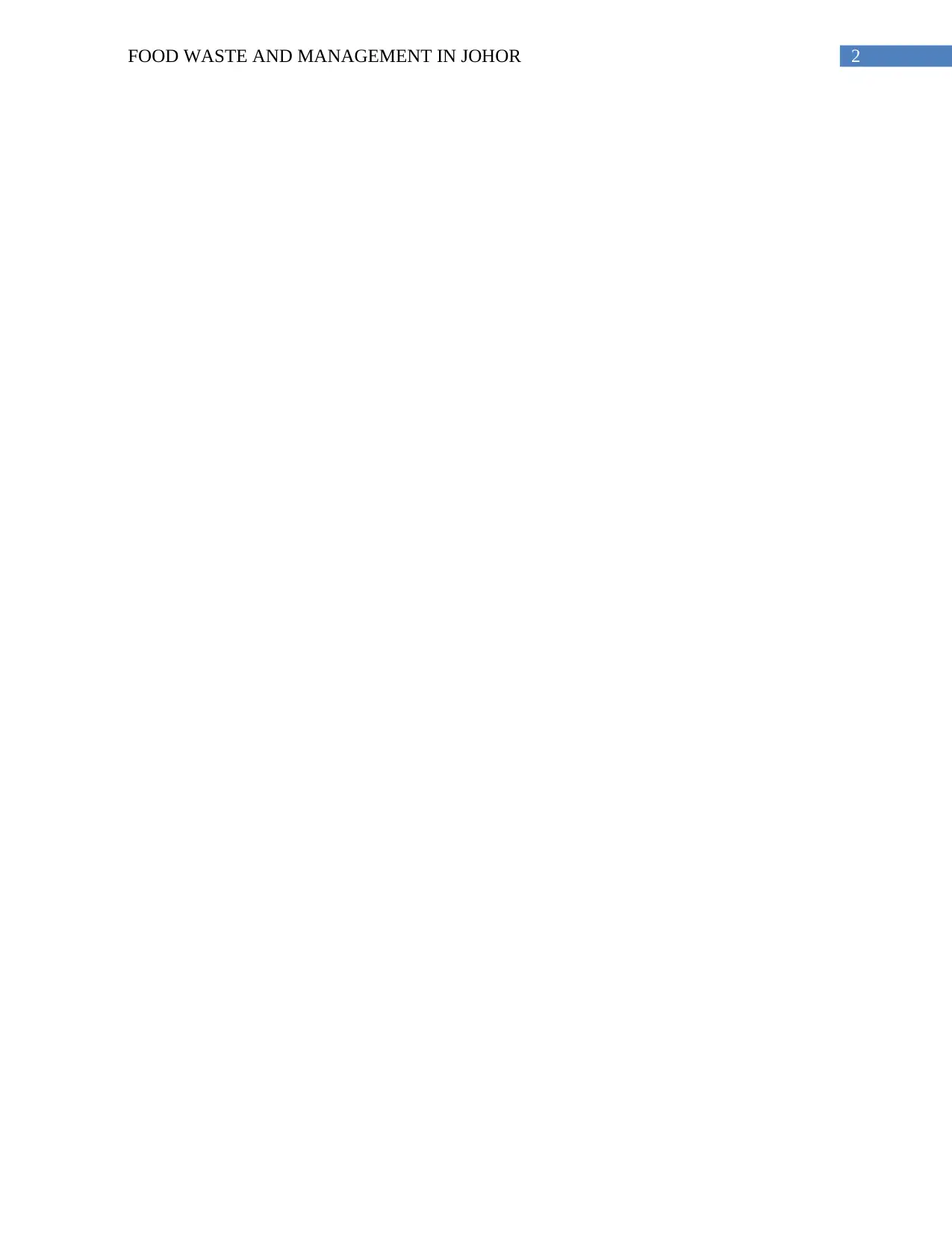
2FOOD WASTE AND MANAGEMENT IN JOHOR
⊘ This is a preview!⊘
Do you want full access?
Subscribe today to unlock all pages.

Trusted by 1+ million students worldwide
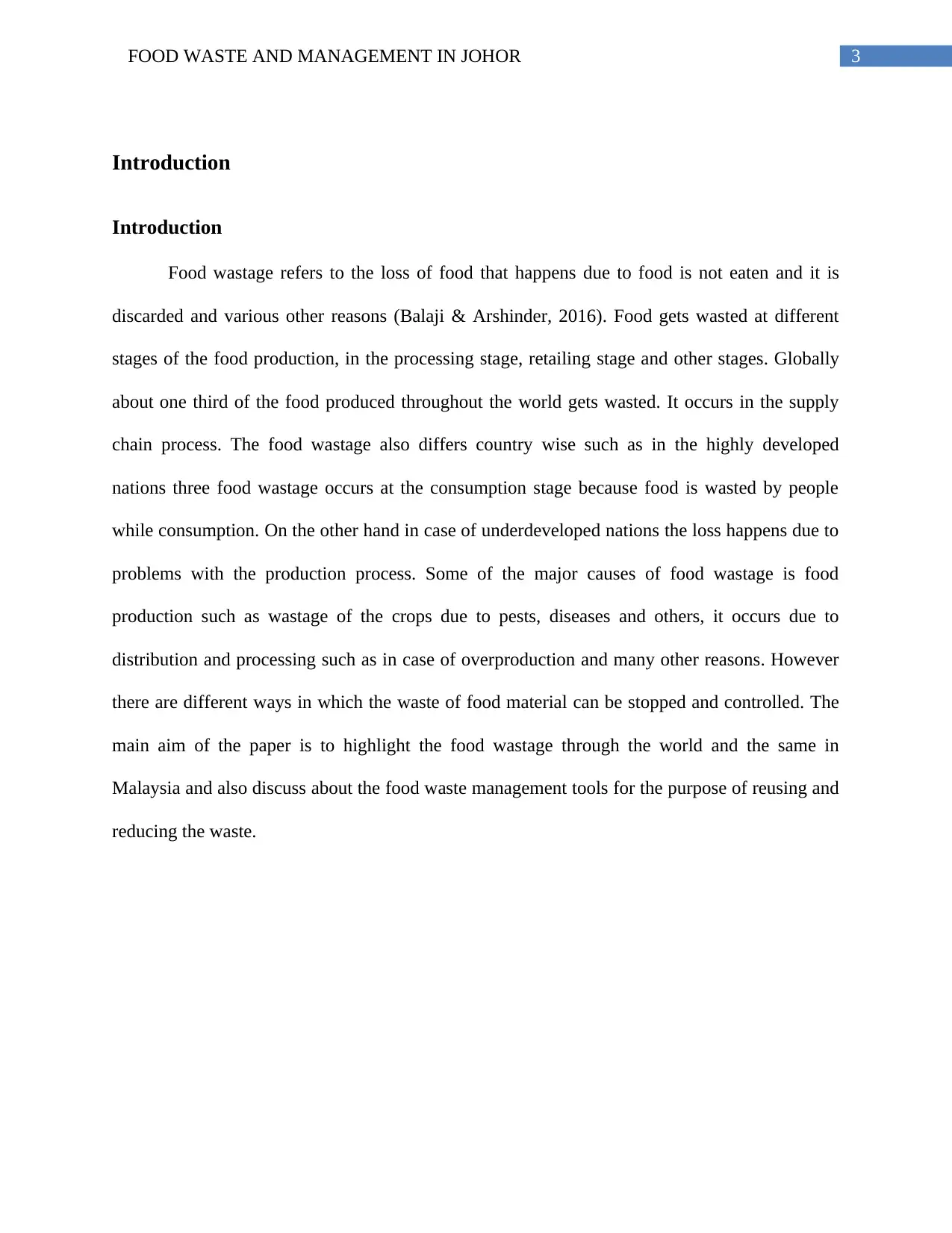
3FOOD WASTE AND MANAGEMENT IN JOHOR
Introduction
Introduction
Food wastage refers to the loss of food that happens due to food is not eaten and it is
discarded and various other reasons (Balaji & Arshinder, 2016). Food gets wasted at different
stages of the food production, in the processing stage, retailing stage and other stages. Globally
about one third of the food produced throughout the world gets wasted. It occurs in the supply
chain process. The food wastage also differs country wise such as in the highly developed
nations three food wastage occurs at the consumption stage because food is wasted by people
while consumption. On the other hand in case of underdeveloped nations the loss happens due to
problems with the production process. Some of the major causes of food wastage is food
production such as wastage of the crops due to pests, diseases and others, it occurs due to
distribution and processing such as in case of overproduction and many other reasons. However
there are different ways in which the waste of food material can be stopped and controlled. The
main aim of the paper is to highlight the food wastage through the world and the same in
Malaysia and also discuss about the food waste management tools for the purpose of reusing and
reducing the waste.
Introduction
Introduction
Food wastage refers to the loss of food that happens due to food is not eaten and it is
discarded and various other reasons (Balaji & Arshinder, 2016). Food gets wasted at different
stages of the food production, in the processing stage, retailing stage and other stages. Globally
about one third of the food produced throughout the world gets wasted. It occurs in the supply
chain process. The food wastage also differs country wise such as in the highly developed
nations three food wastage occurs at the consumption stage because food is wasted by people
while consumption. On the other hand in case of underdeveloped nations the loss happens due to
problems with the production process. Some of the major causes of food wastage is food
production such as wastage of the crops due to pests, diseases and others, it occurs due to
distribution and processing such as in case of overproduction and many other reasons. However
there are different ways in which the waste of food material can be stopped and controlled. The
main aim of the paper is to highlight the food wastage through the world and the same in
Malaysia and also discuss about the food waste management tools for the purpose of reusing and
reducing the waste.
Paraphrase This Document
Need a fresh take? Get an instant paraphrase of this document with our AI Paraphraser
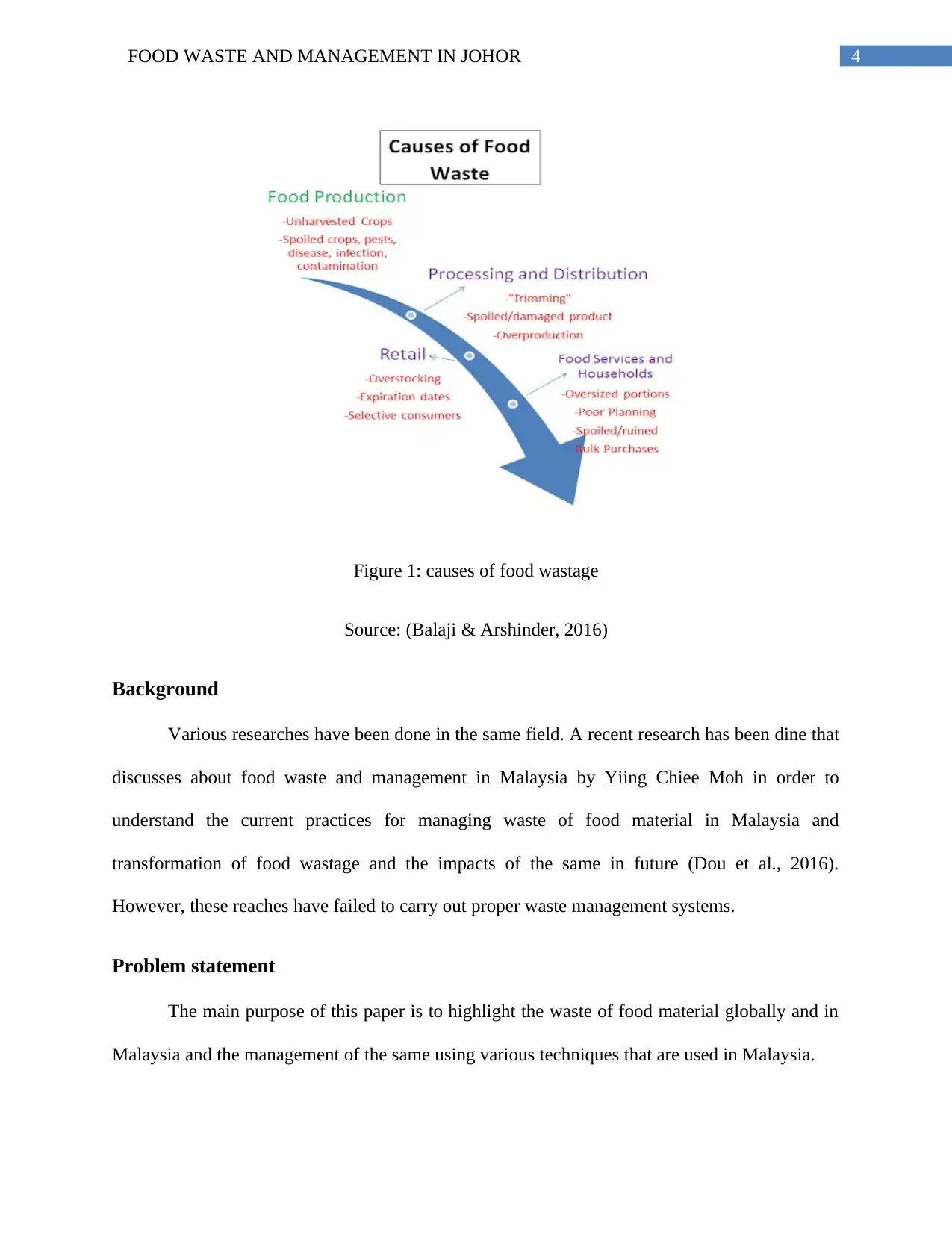
4FOOD WASTE AND MANAGEMENT IN JOHOR
Figure 1: causes of food wastage
Source: (Balaji & Arshinder, 2016)
Background
Various researches have been done in the same field. A recent research has been dine that
discusses about food waste and management in Malaysia by Yiing Chiee Moh in order to
understand the current practices for managing waste of food material in Malaysia and
transformation of food wastage and the impacts of the same in future (Dou et al., 2016).
However, these reaches have failed to carry out proper waste management systems.
Problem statement
The main purpose of this paper is to highlight the waste of food material globally and in
Malaysia and the management of the same using various techniques that are used in Malaysia.
Figure 1: causes of food wastage
Source: (Balaji & Arshinder, 2016)
Background
Various researches have been done in the same field. A recent research has been dine that
discusses about food waste and management in Malaysia by Yiing Chiee Moh in order to
understand the current practices for managing waste of food material in Malaysia and
transformation of food wastage and the impacts of the same in future (Dou et al., 2016).
However, these reaches have failed to carry out proper waste management systems.
Problem statement
The main purpose of this paper is to highlight the waste of food material globally and in
Malaysia and the management of the same using various techniques that are used in Malaysia.
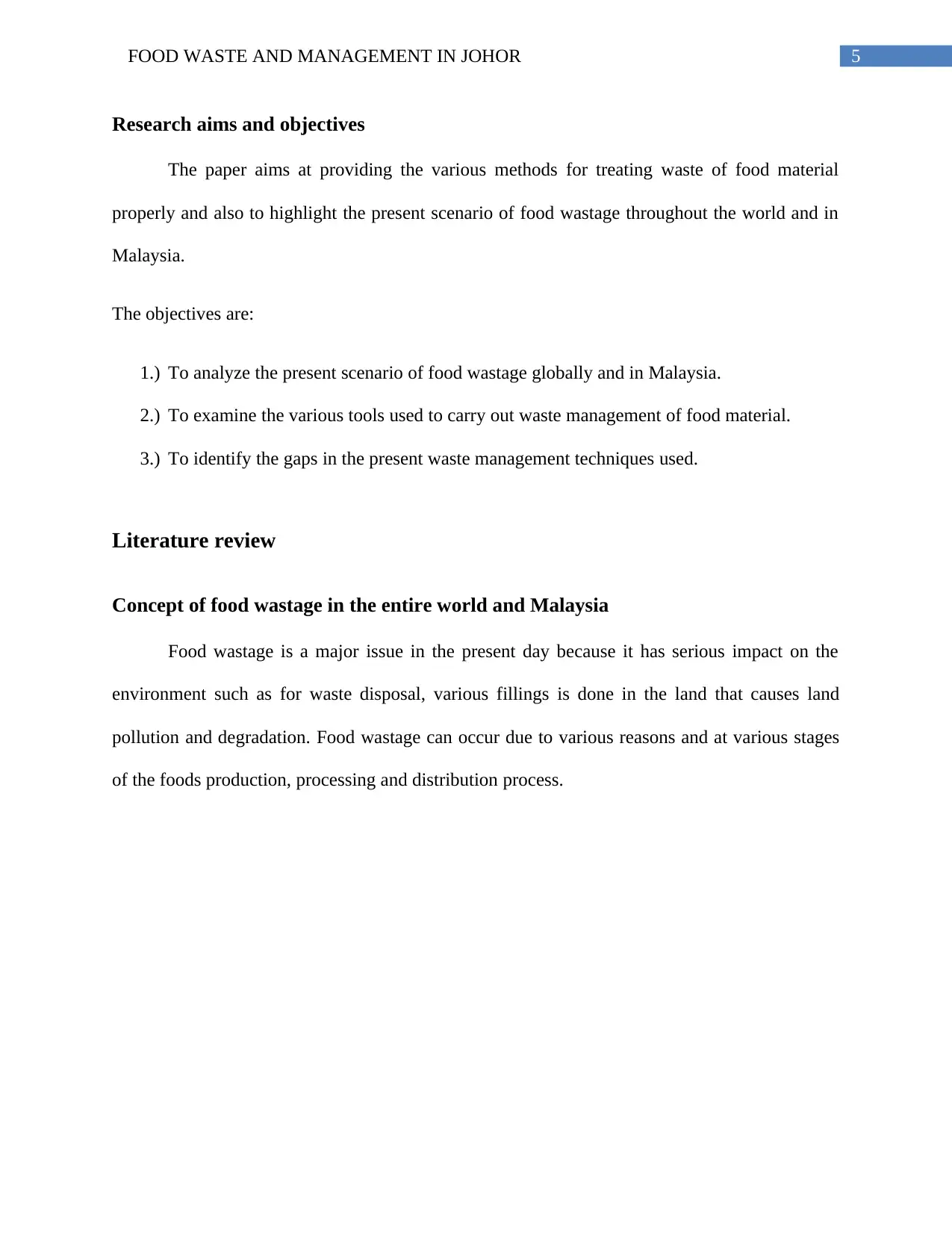
5FOOD WASTE AND MANAGEMENT IN JOHOR
Research aims and objectives
The paper aims at providing the various methods for treating waste of food material
properly and also to highlight the present scenario of food wastage throughout the world and in
Malaysia.
The objectives are:
1.) To analyze the present scenario of food wastage globally and in Malaysia.
2.) To examine the various tools used to carry out waste management of food material.
3.) To identify the gaps in the present waste management techniques used.
Literature review
Concept of food wastage in the entire world and Malaysia
Food wastage is a major issue in the present day because it has serious impact on the
environment such as for waste disposal, various fillings is done in the land that causes land
pollution and degradation. Food wastage can occur due to various reasons and at various stages
of the foods production, processing and distribution process.
Research aims and objectives
The paper aims at providing the various methods for treating waste of food material
properly and also to highlight the present scenario of food wastage throughout the world and in
Malaysia.
The objectives are:
1.) To analyze the present scenario of food wastage globally and in Malaysia.
2.) To examine the various tools used to carry out waste management of food material.
3.) To identify the gaps in the present waste management techniques used.
Literature review
Concept of food wastage in the entire world and Malaysia
Food wastage is a major issue in the present day because it has serious impact on the
environment such as for waste disposal, various fillings is done in the land that causes land
pollution and degradation. Food wastage can occur due to various reasons and at various stages
of the foods production, processing and distribution process.
⊘ This is a preview!⊘
Do you want full access?
Subscribe today to unlock all pages.

Trusted by 1+ million students worldwide
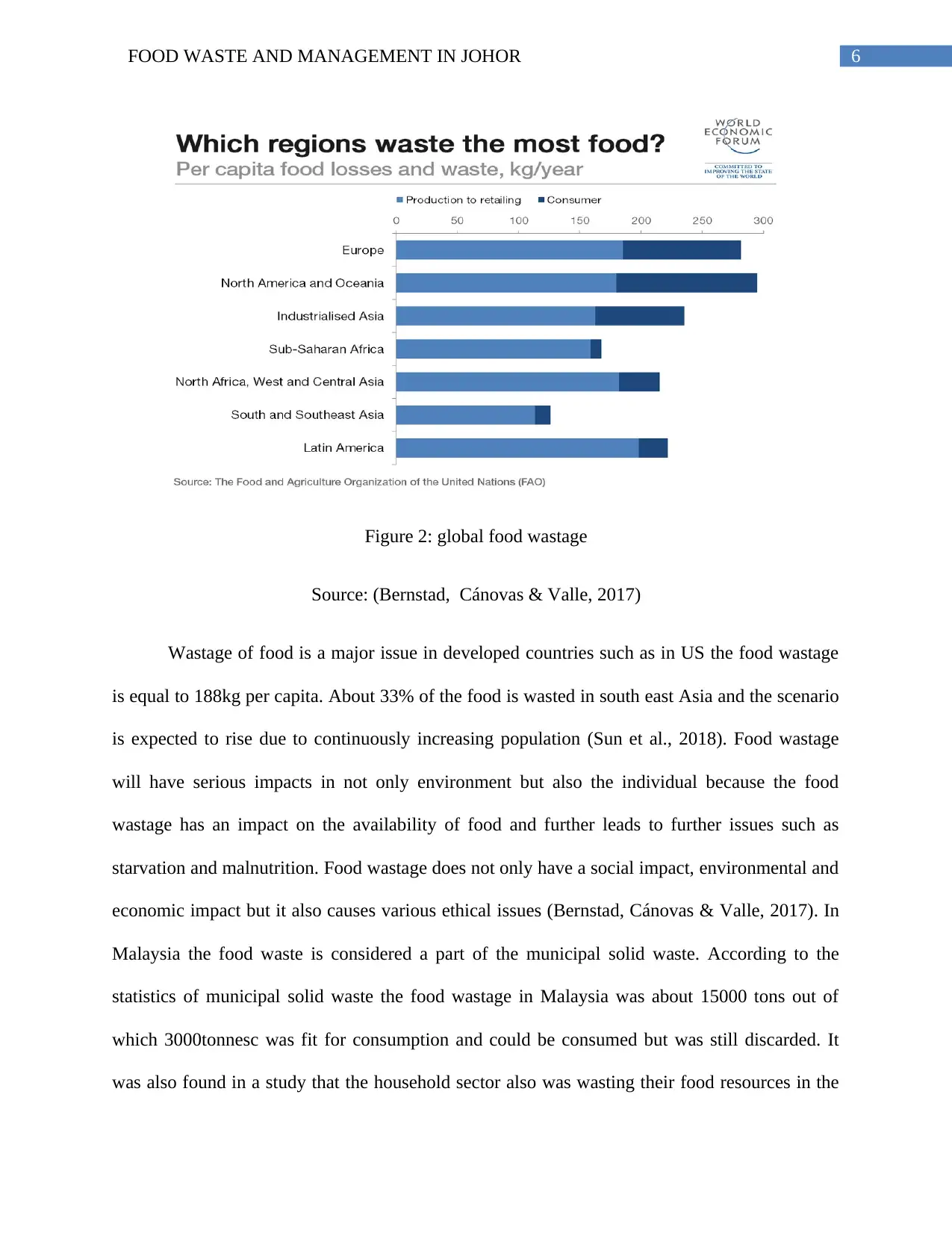
6FOOD WASTE AND MANAGEMENT IN JOHOR
Figure 2: global food wastage
Source: (Bernstad, Cánovas & Valle, 2017)
Wastage of food is a major issue in developed countries such as in US the food wastage
is equal to 188kg per capita. About 33% of the food is wasted in south east Asia and the scenario
is expected to rise due to continuously increasing population (Sun et al., 2018). Food wastage
will have serious impacts in not only environment but also the individual because the food
wastage has an impact on the availability of food and further leads to further issues such as
starvation and malnutrition. Food wastage does not only have a social impact, environmental and
economic impact but it also causes various ethical issues (Bernstad, Cánovas & Valle, 2017). In
Malaysia the food waste is considered a part of the municipal solid waste. According to the
statistics of municipal solid waste the food wastage in Malaysia was about 15000 tons out of
which 3000tonnesc was fit for consumption and could be consumed but was still discarded. It
was also found in a study that the household sector also was wasting their food resources in the
Figure 2: global food wastage
Source: (Bernstad, Cánovas & Valle, 2017)
Wastage of food is a major issue in developed countries such as in US the food wastage
is equal to 188kg per capita. About 33% of the food is wasted in south east Asia and the scenario
is expected to rise due to continuously increasing population (Sun et al., 2018). Food wastage
will have serious impacts in not only environment but also the individual because the food
wastage has an impact on the availability of food and further leads to further issues such as
starvation and malnutrition. Food wastage does not only have a social impact, environmental and
economic impact but it also causes various ethical issues (Bernstad, Cánovas & Valle, 2017). In
Malaysia the food waste is considered a part of the municipal solid waste. According to the
statistics of municipal solid waste the food wastage in Malaysia was about 15000 tons out of
which 3000tonnesc was fit for consumption and could be consumed but was still discarded. It
was also found in a study that the household sector also was wasting their food resources in the
Paraphrase This Document
Need a fresh take? Get an instant paraphrase of this document with our AI Paraphraser
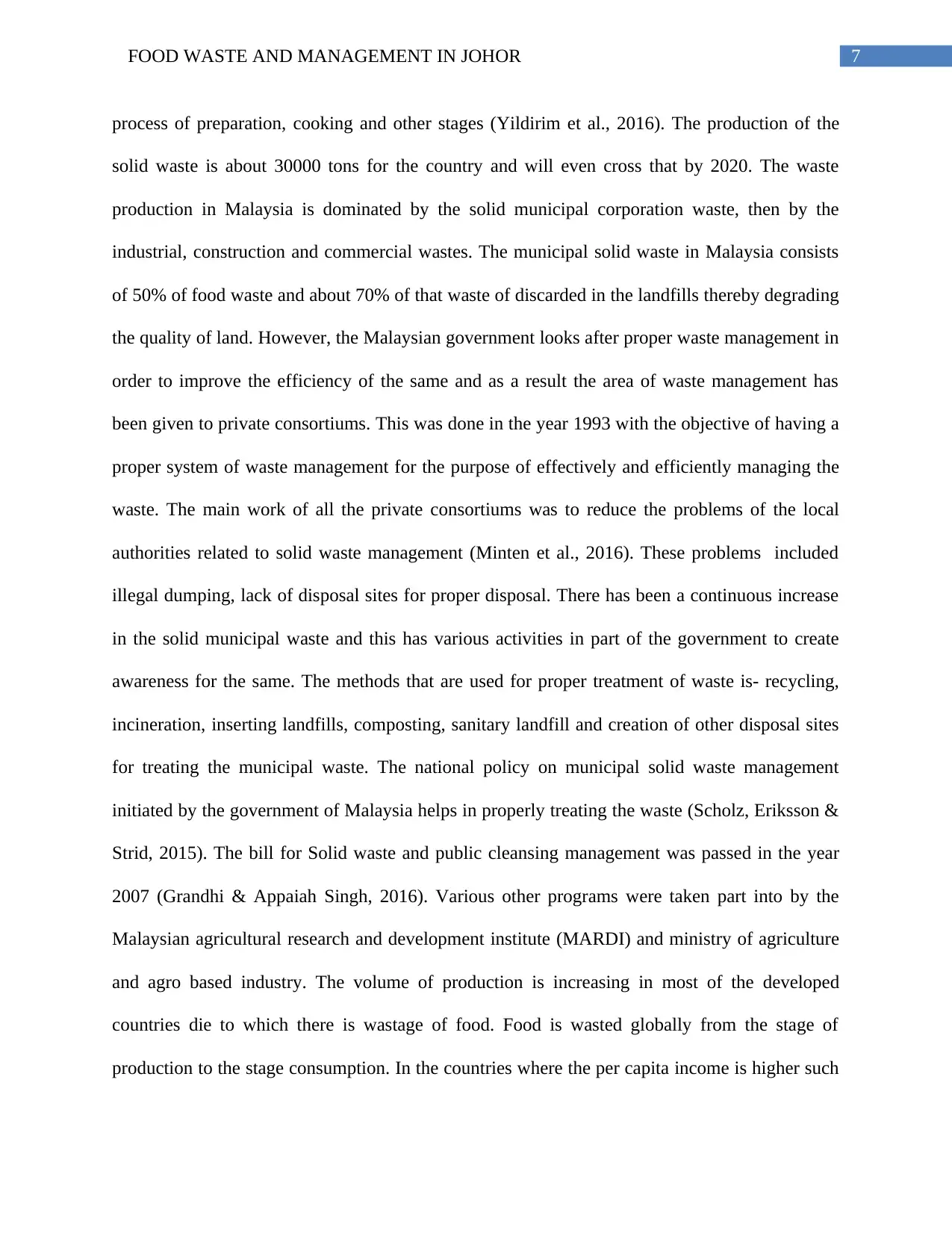
7FOOD WASTE AND MANAGEMENT IN JOHOR
process of preparation, cooking and other stages (Yildirim et al., 2016). The production of the
solid waste is about 30000 tons for the country and will even cross that by 2020. The waste
production in Malaysia is dominated by the solid municipal corporation waste, then by the
industrial, construction and commercial wastes. The municipal solid waste in Malaysia consists
of 50% of food waste and about 70% of that waste of discarded in the landfills thereby degrading
the quality of land. However, the Malaysian government looks after proper waste management in
order to improve the efficiency of the same and as a result the area of waste management has
been given to private consortiums. This was done in the year 1993 with the objective of having a
proper system of waste management for the purpose of effectively and efficiently managing the
waste. The main work of all the private consortiums was to reduce the problems of the local
authorities related to solid waste management (Minten et al., 2016). These problems included
illegal dumping, lack of disposal sites for proper disposal. There has been a continuous increase
in the solid municipal waste and this has various activities in part of the government to create
awareness for the same. The methods that are used for proper treatment of waste is- recycling,
incineration, inserting landfills, composting, sanitary landfill and creation of other disposal sites
for treating the municipal waste. The national policy on municipal solid waste management
initiated by the government of Malaysia helps in properly treating the waste (Scholz, Eriksson &
Strid, 2015). The bill for Solid waste and public cleansing management was passed in the year
2007 (Grandhi & Appaiah Singh, 2016). Various other programs were taken part into by the
Malaysian agricultural research and development institute (MARDI) and ministry of agriculture
and agro based industry. The volume of production is increasing in most of the developed
countries die to which there is wastage of food. Food is wasted globally from the stage of
production to the stage consumption. In the countries where the per capita income is higher such
process of preparation, cooking and other stages (Yildirim et al., 2016). The production of the
solid waste is about 30000 tons for the country and will even cross that by 2020. The waste
production in Malaysia is dominated by the solid municipal corporation waste, then by the
industrial, construction and commercial wastes. The municipal solid waste in Malaysia consists
of 50% of food waste and about 70% of that waste of discarded in the landfills thereby degrading
the quality of land. However, the Malaysian government looks after proper waste management in
order to improve the efficiency of the same and as a result the area of waste management has
been given to private consortiums. This was done in the year 1993 with the objective of having a
proper system of waste management for the purpose of effectively and efficiently managing the
waste. The main work of all the private consortiums was to reduce the problems of the local
authorities related to solid waste management (Minten et al., 2016). These problems included
illegal dumping, lack of disposal sites for proper disposal. There has been a continuous increase
in the solid municipal waste and this has various activities in part of the government to create
awareness for the same. The methods that are used for proper treatment of waste is- recycling,
incineration, inserting landfills, composting, sanitary landfill and creation of other disposal sites
for treating the municipal waste. The national policy on municipal solid waste management
initiated by the government of Malaysia helps in properly treating the waste (Scholz, Eriksson &
Strid, 2015). The bill for Solid waste and public cleansing management was passed in the year
2007 (Grandhi & Appaiah Singh, 2016). Various other programs were taken part into by the
Malaysian agricultural research and development institute (MARDI) and ministry of agriculture
and agro based industry. The volume of production is increasing in most of the developed
countries die to which there is wastage of food. Food is wasted globally from the stage of
production to the stage consumption. In the countries where the per capita income is higher such
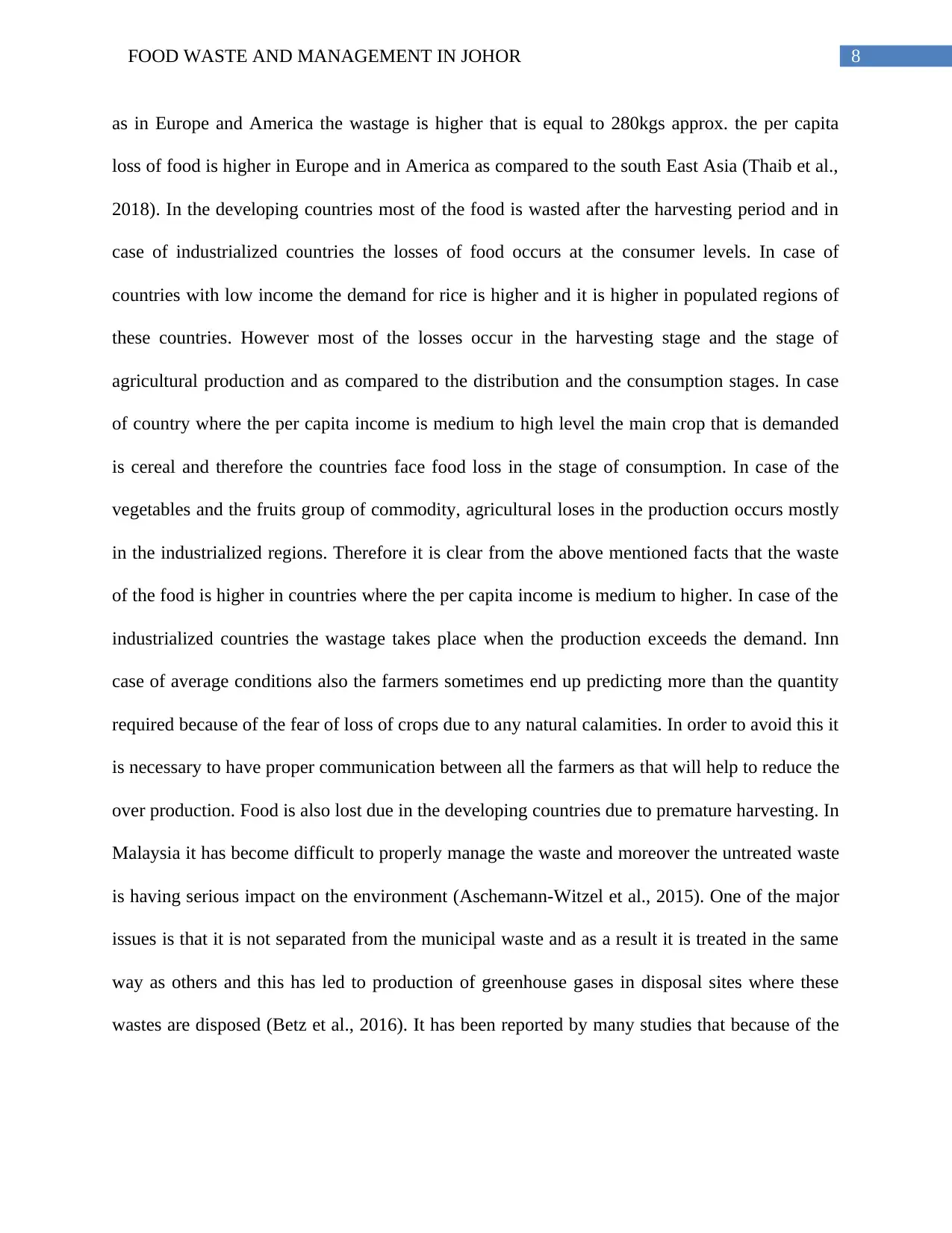
8FOOD WASTE AND MANAGEMENT IN JOHOR
as in Europe and America the wastage is higher that is equal to 280kgs approx. the per capita
loss of food is higher in Europe and in America as compared to the south East Asia (Thaib et al.,
2018). In the developing countries most of the food is wasted after the harvesting period and in
case of industrialized countries the losses of food occurs at the consumer levels. In case of
countries with low income the demand for rice is higher and it is higher in populated regions of
these countries. However most of the losses occur in the harvesting stage and the stage of
agricultural production and as compared to the distribution and the consumption stages. In case
of country where the per capita income is medium to high level the main crop that is demanded
is cereal and therefore the countries face food loss in the stage of consumption. In case of the
vegetables and the fruits group of commodity, agricultural loses in the production occurs mostly
in the industrialized regions. Therefore it is clear from the above mentioned facts that the waste
of the food is higher in countries where the per capita income is medium to higher. In case of the
industrialized countries the wastage takes place when the production exceeds the demand. Inn
case of average conditions also the farmers sometimes end up predicting more than the quantity
required because of the fear of loss of crops due to any natural calamities. In order to avoid this it
is necessary to have proper communication between all the farmers as that will help to reduce the
over production. Food is also lost due in the developing countries due to premature harvesting. In
Malaysia it has become difficult to properly manage the waste and moreover the untreated waste
is having serious impact on the environment (Aschemann-Witzel et al., 2015). One of the major
issues is that it is not separated from the municipal waste and as a result it is treated in the same
way as others and this has led to production of greenhouse gases in disposal sites where these
wastes are disposed (Betz et al., 2016). It has been reported by many studies that because of the
as in Europe and America the wastage is higher that is equal to 280kgs approx. the per capita
loss of food is higher in Europe and in America as compared to the south East Asia (Thaib et al.,
2018). In the developing countries most of the food is wasted after the harvesting period and in
case of industrialized countries the losses of food occurs at the consumer levels. In case of
countries with low income the demand for rice is higher and it is higher in populated regions of
these countries. However most of the losses occur in the harvesting stage and the stage of
agricultural production and as compared to the distribution and the consumption stages. In case
of country where the per capita income is medium to high level the main crop that is demanded
is cereal and therefore the countries face food loss in the stage of consumption. In case of the
vegetables and the fruits group of commodity, agricultural loses in the production occurs mostly
in the industrialized regions. Therefore it is clear from the above mentioned facts that the waste
of the food is higher in countries where the per capita income is medium to higher. In case of the
industrialized countries the wastage takes place when the production exceeds the demand. Inn
case of average conditions also the farmers sometimes end up predicting more than the quantity
required because of the fear of loss of crops due to any natural calamities. In order to avoid this it
is necessary to have proper communication between all the farmers as that will help to reduce the
over production. Food is also lost due in the developing countries due to premature harvesting. In
Malaysia it has become difficult to properly manage the waste and moreover the untreated waste
is having serious impact on the environment (Aschemann-Witzel et al., 2015). One of the major
issues is that it is not separated from the municipal waste and as a result it is treated in the same
way as others and this has led to production of greenhouse gases in disposal sites where these
wastes are disposed (Betz et al., 2016). It has been reported by many studies that because of the
⊘ This is a preview!⊘
Do you want full access?
Subscribe today to unlock all pages.

Trusted by 1+ million students worldwide
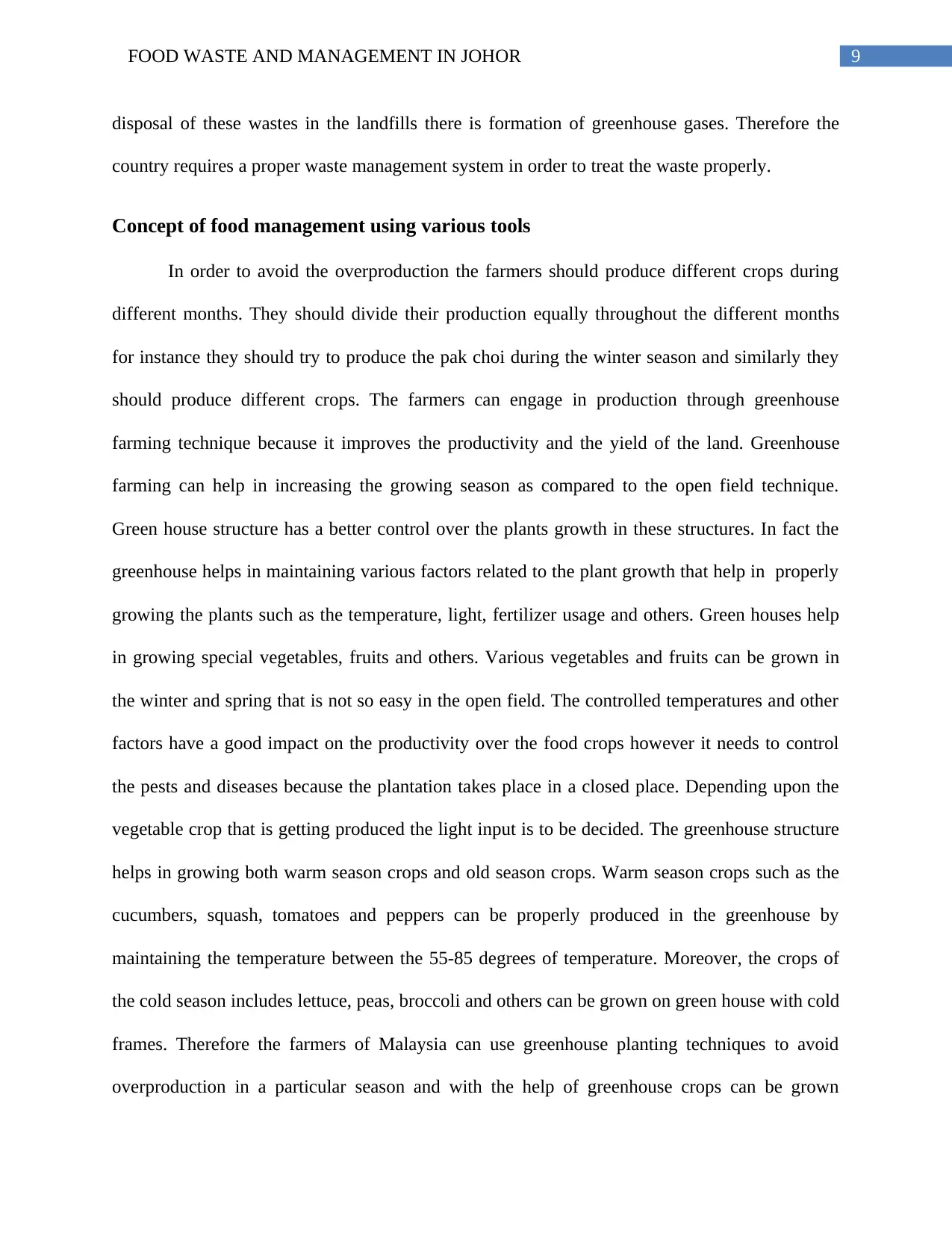
9FOOD WASTE AND MANAGEMENT IN JOHOR
disposal of these wastes in the landfills there is formation of greenhouse gases. Therefore the
country requires a proper waste management system in order to treat the waste properly.
Concept of food management using various tools
In order to avoid the overproduction the farmers should produce different crops during
different months. They should divide their production equally throughout the different months
for instance they should try to produce the pak choi during the winter season and similarly they
should produce different crops. The farmers can engage in production through greenhouse
farming technique because it improves the productivity and the yield of the land. Greenhouse
farming can help in increasing the growing season as compared to the open field technique.
Green house structure has a better control over the plants growth in these structures. In fact the
greenhouse helps in maintaining various factors related to the plant growth that help in properly
growing the plants such as the temperature, light, fertilizer usage and others. Green houses help
in growing special vegetables, fruits and others. Various vegetables and fruits can be grown in
the winter and spring that is not so easy in the open field. The controlled temperatures and other
factors have a good impact on the productivity over the food crops however it needs to control
the pests and diseases because the plantation takes place in a closed place. Depending upon the
vegetable crop that is getting produced the light input is to be decided. The greenhouse structure
helps in growing both warm season crops and old season crops. Warm season crops such as the
cucumbers, squash, tomatoes and peppers can be properly produced in the greenhouse by
maintaining the temperature between the 55-85 degrees of temperature. Moreover, the crops of
the cold season includes lettuce, peas, broccoli and others can be grown on green house with cold
frames. Therefore the farmers of Malaysia can use greenhouse planting techniques to avoid
overproduction in a particular season and with the help of greenhouse crops can be grown
disposal of these wastes in the landfills there is formation of greenhouse gases. Therefore the
country requires a proper waste management system in order to treat the waste properly.
Concept of food management using various tools
In order to avoid the overproduction the farmers should produce different crops during
different months. They should divide their production equally throughout the different months
for instance they should try to produce the pak choi during the winter season and similarly they
should produce different crops. The farmers can engage in production through greenhouse
farming technique because it improves the productivity and the yield of the land. Greenhouse
farming can help in increasing the growing season as compared to the open field technique.
Green house structure has a better control over the plants growth in these structures. In fact the
greenhouse helps in maintaining various factors related to the plant growth that help in properly
growing the plants such as the temperature, light, fertilizer usage and others. Green houses help
in growing special vegetables, fruits and others. Various vegetables and fruits can be grown in
the winter and spring that is not so easy in the open field. The controlled temperatures and other
factors have a good impact on the productivity over the food crops however it needs to control
the pests and diseases because the plantation takes place in a closed place. Depending upon the
vegetable crop that is getting produced the light input is to be decided. The greenhouse structure
helps in growing both warm season crops and old season crops. Warm season crops such as the
cucumbers, squash, tomatoes and peppers can be properly produced in the greenhouse by
maintaining the temperature between the 55-85 degrees of temperature. Moreover, the crops of
the cold season includes lettuce, peas, broccoli and others can be grown on green house with cold
frames. Therefore the farmers of Malaysia can use greenhouse planting techniques to avoid
overproduction in a particular season and with the help of greenhouse crops can be grown
Paraphrase This Document
Need a fresh take? Get an instant paraphrase of this document with our AI Paraphraser
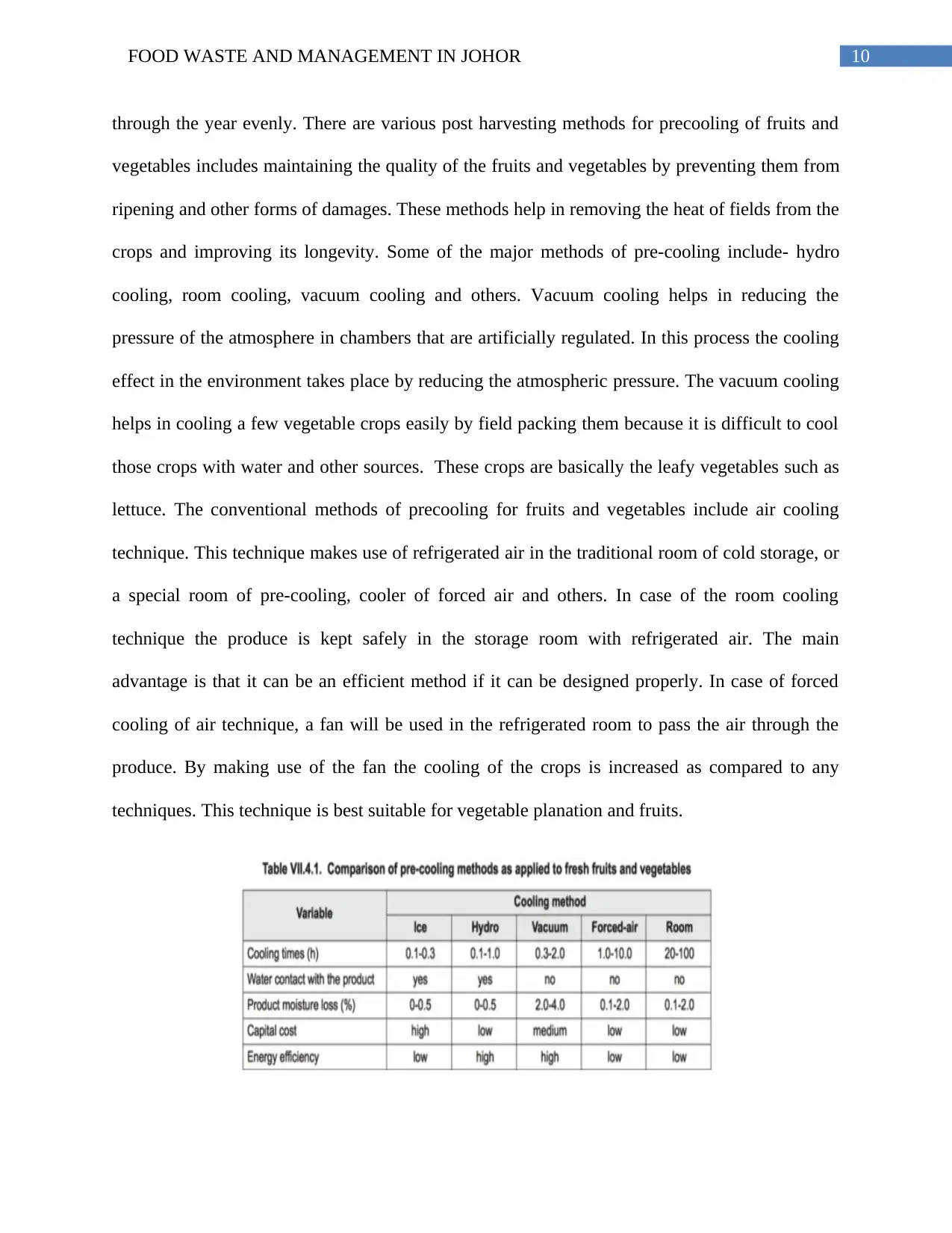
10FOOD WASTE AND MANAGEMENT IN JOHOR
through the year evenly. There are various post harvesting methods for precooling of fruits and
vegetables includes maintaining the quality of the fruits and vegetables by preventing them from
ripening and other forms of damages. These methods help in removing the heat of fields from the
crops and improving its longevity. Some of the major methods of pre-cooling include- hydro
cooling, room cooling, vacuum cooling and others. Vacuum cooling helps in reducing the
pressure of the atmosphere in chambers that are artificially regulated. In this process the cooling
effect in the environment takes place by reducing the atmospheric pressure. The vacuum cooling
helps in cooling a few vegetable crops easily by field packing them because it is difficult to cool
those crops with water and other sources. These crops are basically the leafy vegetables such as
lettuce. The conventional methods of precooling for fruits and vegetables include air cooling
technique. This technique makes use of refrigerated air in the traditional room of cold storage, or
a special room of pre-cooling, cooler of forced air and others. In case of the room cooling
technique the produce is kept safely in the storage room with refrigerated air. The main
advantage is that it can be an efficient method if it can be designed properly. In case of forced
cooling of air technique, a fan will be used in the refrigerated room to pass the air through the
produce. By making use of the fan the cooling of the crops is increased as compared to any
techniques. This technique is best suitable for vegetable planation and fruits.
through the year evenly. There are various post harvesting methods for precooling of fruits and
vegetables includes maintaining the quality of the fruits and vegetables by preventing them from
ripening and other forms of damages. These methods help in removing the heat of fields from the
crops and improving its longevity. Some of the major methods of pre-cooling include- hydro
cooling, room cooling, vacuum cooling and others. Vacuum cooling helps in reducing the
pressure of the atmosphere in chambers that are artificially regulated. In this process the cooling
effect in the environment takes place by reducing the atmospheric pressure. The vacuum cooling
helps in cooling a few vegetable crops easily by field packing them because it is difficult to cool
those crops with water and other sources. These crops are basically the leafy vegetables such as
lettuce. The conventional methods of precooling for fruits and vegetables include air cooling
technique. This technique makes use of refrigerated air in the traditional room of cold storage, or
a special room of pre-cooling, cooler of forced air and others. In case of the room cooling
technique the produce is kept safely in the storage room with refrigerated air. The main
advantage is that it can be an efficient method if it can be designed properly. In case of forced
cooling of air technique, a fan will be used in the refrigerated room to pass the air through the
produce. By making use of the fan the cooling of the crops is increased as compared to any
techniques. This technique is best suitable for vegetable planation and fruits.
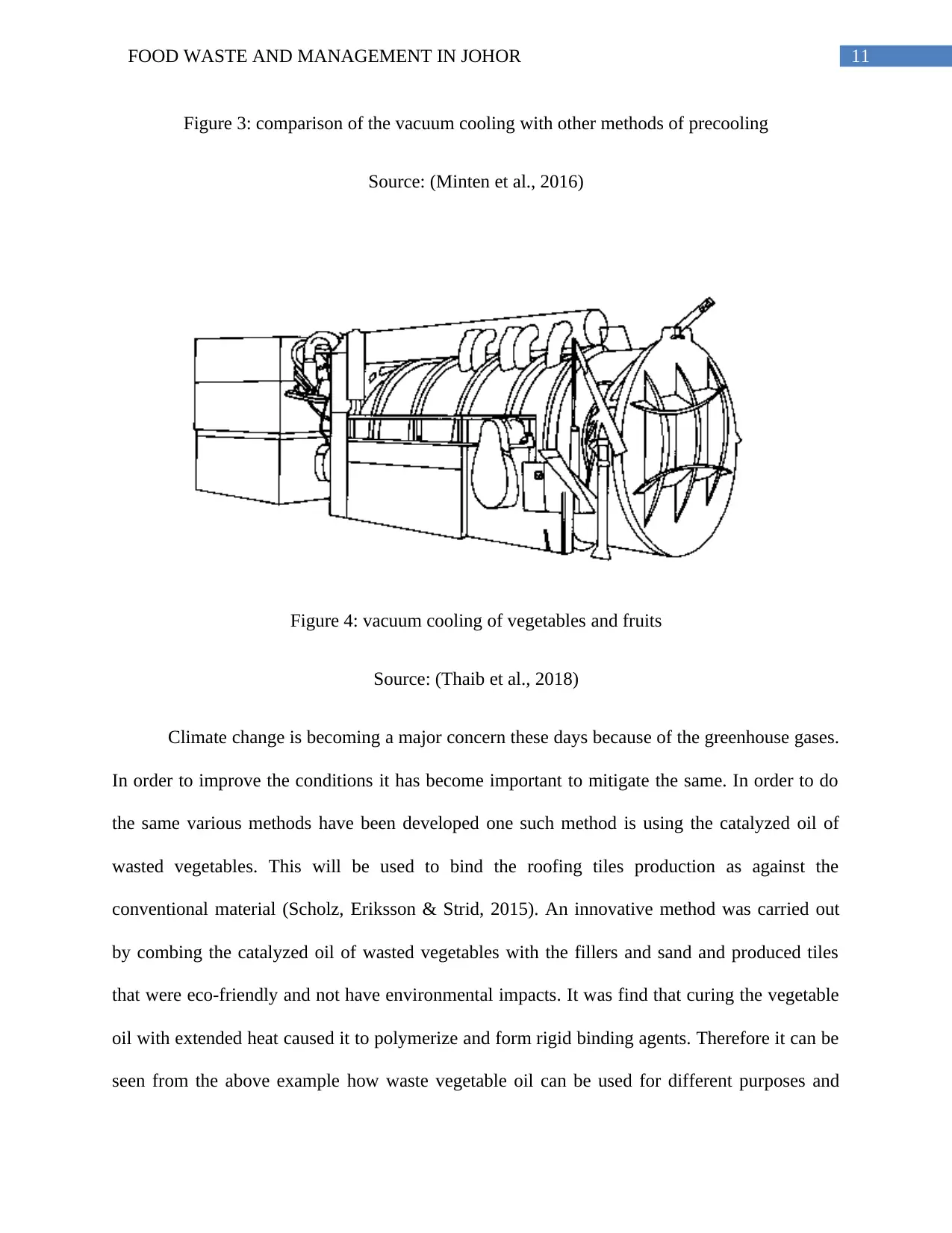
11FOOD WASTE AND MANAGEMENT IN JOHOR
Figure 3: comparison of the vacuum cooling with other methods of precooling
Source: (Minten et al., 2016)
Figure 4: vacuum cooling of vegetables and fruits
Source: (Thaib et al., 2018)
Climate change is becoming a major concern these days because of the greenhouse gases.
In order to improve the conditions it has become important to mitigate the same. In order to do
the same various methods have been developed one such method is using the catalyzed oil of
wasted vegetables. This will be used to bind the roofing tiles production as against the
conventional material (Scholz, Eriksson & Strid, 2015). An innovative method was carried out
by combing the catalyzed oil of wasted vegetables with the fillers and sand and produced tiles
that were eco-friendly and not have environmental impacts. It was find that curing the vegetable
oil with extended heat caused it to polymerize and form rigid binding agents. Therefore it can be
seen from the above example how waste vegetable oil can be used for different purposes and
Figure 3: comparison of the vacuum cooling with other methods of precooling
Source: (Minten et al., 2016)
Figure 4: vacuum cooling of vegetables and fruits
Source: (Thaib et al., 2018)
Climate change is becoming a major concern these days because of the greenhouse gases.
In order to improve the conditions it has become important to mitigate the same. In order to do
the same various methods have been developed one such method is using the catalyzed oil of
wasted vegetables. This will be used to bind the roofing tiles production as against the
conventional material (Scholz, Eriksson & Strid, 2015). An innovative method was carried out
by combing the catalyzed oil of wasted vegetables with the fillers and sand and produced tiles
that were eco-friendly and not have environmental impacts. It was find that curing the vegetable
oil with extended heat caused it to polymerize and form rigid binding agents. Therefore it can be
seen from the above example how waste vegetable oil can be used for different purposes and
⊘ This is a preview!⊘
Do you want full access?
Subscribe today to unlock all pages.

Trusted by 1+ million students worldwide
1 out of 20
Related Documents
Your All-in-One AI-Powered Toolkit for Academic Success.
+13062052269
info@desklib.com
Available 24*7 on WhatsApp / Email
![[object Object]](/_next/static/media/star-bottom.7253800d.svg)
Unlock your academic potential
Copyright © 2020–2025 A2Z Services. All Rights Reserved. Developed and managed by ZUCOL.





